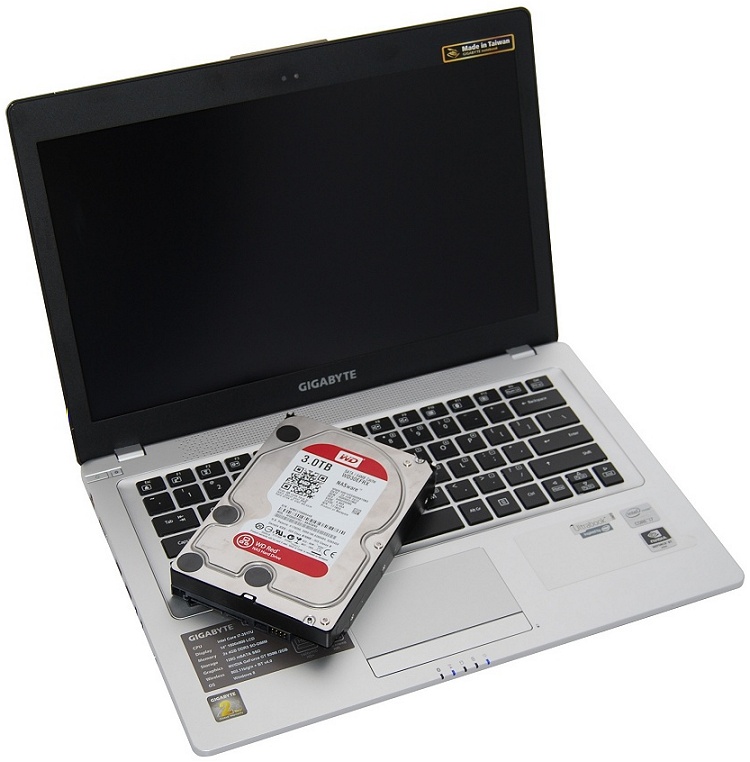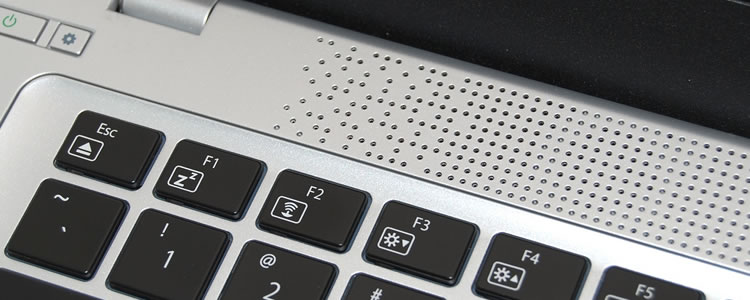Usage Impressions and Final Thoughts
Gigabyte ships the U2442F configured with Windows 7 or Windows 8, our test unit came loaded with Windows 8 along with a few other applications such as PowerDVD, Microsoft Office and THX TruStudio Pro. Fortunately there was little to no bloatware preinstalled and so we hope this is how all U2442F ultrabooks ship to the public.
Picking up and moving the U2442F around is made easy by its lightweight and compact design. Connecting different peripherals was a breeze as ports are easily accessed on either side of the laptop.


The charging port is on the right hand side at the back which is a typical location for most laptops. With a pair of USB ports on each side, and well spaced apart to boot, it is possible to simultaneously connect an arsenal of USB devices. The SD card reader is also a nice touch if you don't want to attach a bulky DSLR camera when on the go.
Opening the screen requires pushing no clips or buttons. The lid fights to remain shut until you pull it past about the 70mm mark and then it opens without any objection. It's very easy to open and I found that the screen never opened by mistake.
The only thing to keep in mind here is that the screen doesn't open flat like what we've seen from other ultrabooks, particularly Lenovo's. Instead it opens to about a 135 degree angle which is more typical.
Once open the U2442F isn't the most slick looking ultrabook but it is very functional. Whereas most match the color of the deck to the screen bezel to give that slick look, Gigabyte hasn't. Instead the screen has been given a black border and we feel this is actually more functional as it blends in and doesn't clash with the screen.

The deck is well laid out and we found that the trackpad worked very well for both mouse movement and double clicking. There is plenty of room to rest your palms so the U2442F is comfortable to use in tight spots, such as an airplane seat.

The chiclet keyboard is much like others that we have used with little of note or to complain about. Gigabyte has done a great job of clearly labelling the secondary key functions and the white backlight option is a much welcomed addition, great for use in the dark.

The integrated 10 watt speakers are surprisingly powerful. With the volume control in VLC set to 200% the speakers were very loud and remarkably clear for an ultrabook.
Storage wise even power users shouldn't have any problems with the U2442F. With Windows 8 installed and all of our testing programs there was still over 70GB of free space available on the 128GB SSD, while the 750GB hard drive was empty leaving 698GB of storage space. As we have come to expect the Crucial m4 SSD was fast and based on our experiences also very reliable.
Final Thoughts
Without question the Gigabyte U2442F is cutting edge stuff when it comes to ultrabook performance. Armed with a 3rd-Gen Core i7 processor, plenty of memory, and a quality SSD, the U2442F is as capable as a high-end desktop.
Where the U2442F falters is in its GPU performance. Having come to expect so much more from the Nvidia GeForce GT 650M, only to be let down by its use of DDR3 memory, we were disappointed to say the least.
That said, the U2442F still looks good in the graphics department when compared to other ultrabooks which typically rely solely on the integrated HD 4000 graphics. A couple of fancy and well regarded ultrabooks such as the Acer Aspire S7 and Lenovo Yoga 13, for example, both rely on the HD 4000 alone.

Therefore, if you do plan on having some fun, the U2442F is one of the better ultrabooks out there, providing a ~50-100% performance boost over integrated graphics (that's bound to change with Iris soon enough though).
If you are looking at an ultrabook purely for productivity then the Gigabyte U2442F fits the bill, too, particularly if you need something with a little oomph.
However one problem almost all of these Core i7 powered ultrabooks suffer from is battery life. Although the current ultrabook spec asks for at least 5 hours, it all depends on what you are doing.
For light use it is likely possible to hit the 5 hours and 30 minutes that Gigabyte claim the U2442F can run between charges. Though, if you only intend on light use for the U2442F then this probably isn't the ultrabook for you, a Core i3 model would likely suffice.

Should you utilize most of the U2442F's power for extended periods of time you should expect the battery to last just 3 hours as reported by the Futuremark PowerMark software. The PowerMark balanced test actually drained the battery of the U2442F in just 2 hours and 43 minutes. By comparison, the Lenovo Yoga 13 lasted 3 hours and 21 minutes, though the model we tested used a slower Core i5 processor and didn't feature a discrete GPU.
Bottom line, we are happy with the build quality, specifications and performance of the Gigabyte U2442F, but how about value? This Core i7-powered ultrabook appears to be competitively priced at $1250 considering the quality 128GB SSD you get, plus 750GB HDD, 8GB of RAM, and (half optimized) GeForce GT 650M.
Looking at the competition the IdeaPad Yoga 13 costs $1,000 and includes a touchscreen but features a slower Core i5 CPU, half as much RAM, no hard drive and no discrete GPU. Clearly, they are different systems depending on what you are trying to accomplish. For $1300 the Yoga 13 can be kitted out with a 256GB SSD, 8GB of DDR3 memory, but still no hard drive.
Compared to other ultrabooks such as the Samsung Series 5, the Gigabyte U2442F still stacks up well offering more features for the same price. Few ultrabooks that we know of offer discrete graphics solutions, with the best examples being the Asus Zenbook UX32VD (GeForce GT 620M) and Dell XPS 14 (Geforce GT 630M), both of which should provide similar GPU performance to that of the U2442F.
If you are looking for a powerful, high quality ultrabook capable of both work and play then the Gigabyte U2442F should fit the bill nicely.
score
Pros: Very well rounded specs. Crucial m4 SSD is a big win. Good build quality. Great connectivity options and accessibility.
Cons: GPU performance is a dissapointment due to the choice of GDDR memory. Battery life could be better.
